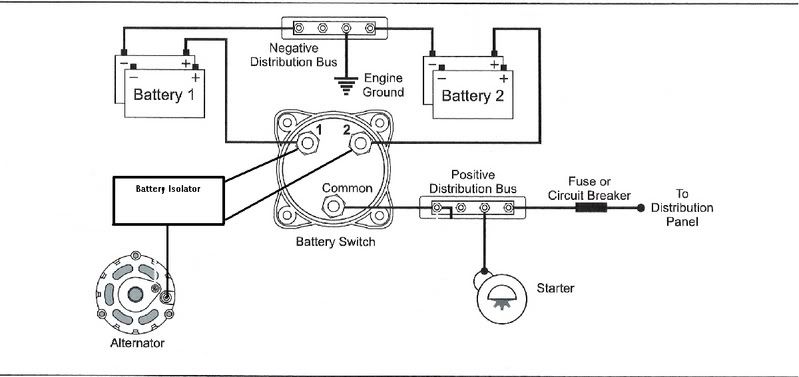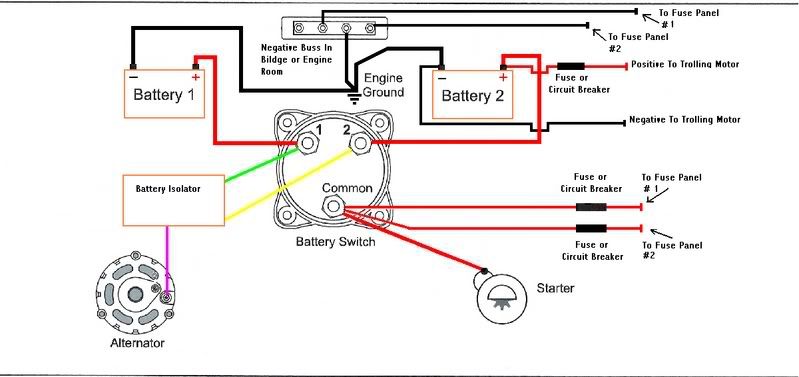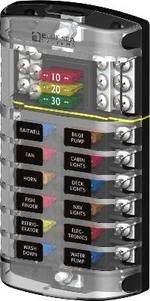swimmin' for shore
Chief Petty Officer
- Joined
- Oct 25, 2004
- Messages
- 490
Okay. I'm not an electrician anymore than I'm a mechanic. It's time to learn to do this stuff, though. The boat that I'm dealing with is a 78 Sea nymph flat bottom aluminum boat that has been modified like a bass boat, with high decks, steering console at the stbd center, and drop down trolling motor at the forward end of the boat. Here's where I'm at, and what I've done. Questions to follow that:
1. The wiring, from front to back of the boat was a bird's nest. It all ran down the stbd side, under the deck. I could access it, but had to do a lot of untying and tracing to figure out what went to what. I reran every piece of wire that looked bad and put in marine grade wiring. I don't have all of the different wires to differentiate, but I got ahold of 7 or 8 different colored electrical tapes, and taped each accessory at 3 foot intervals for easy identification in the future.
2. I cleaned up the whole birdsnest back by the splashwell. It was just a big knot, and I reran or straightened out everything, and then clamped and screwed it into the transom with wire clamps so it all runs in straight lines and is up off the floor, which is obviously going to get wet sometimes. It's very neat now, and I admit to a little bit of pride, not to mention some relief to have it done.
3. I bought 2 deep cycle batteries and installed them in that aft cross-seat, beneath the deck. The interior of that is sealed to be water resistant, and has a wood bottom, but just to keep the batteries from bouncing around, I strapped them in place.
4. Under the fuse box(beneath the steering console) was the next bird nest, and I did pretty much the same thing. I traced and pulled out loose, old wires that no longer go to anything. I straighened, shortened, and clamped everything else. I can actually close the fuse box now. Amazing!
Now we come to the questions. It's been easy enough to straighten up the mess, if a little time consuming. I'm going to buy a perko 3 position switch(1-2-all) tomorrow, and I need to get this thing wired, put the outboard back on, and figure out what goes to where. I don't have any diagrams to go by, but this is how I'm understanding it. If I'm wrong, somewhere along the way, or if anyone can add any insight or anything that I miss, please fix me. I'll thank you a thousand times over.
Battery 1 positive goes to switch, position 1. Batt. 2 pos. to switch position. 2.
Switch gets a hot wire to fuse panel. Is it also wired on a separate wire to the key, which provides the power for the ignition module for the outboard?
All accessories, including bilge pump switches, bow and stern lights, cabin lights, and radio currently run to the fuse panel, which has fuses and toggle switches. I know I need to run a ground from the fuse panel. Do I ground from fuse panel to battery, and then ground from each individual accessory to that ground point on the fuse panel or can I ground accessories individually to the battery and save a whole lot of wire?
Rereading my own writing, I know how people end up with a bird nest of wiring. It's a little confusing. Please understand that I do have a basic understanding of what I'm doing here, but I don't claim to be any kind of electrician. I'm just looking, in the end, to have clean, neat, and safe wiring with 2 batteries(one providing backup power and power to the trolling motor), one switch, one fuse panel, 6 or 8 accessories, and one 35 hp Johnson Seahorse. And if it takes me until spring, I will get this right.
1. The wiring, from front to back of the boat was a bird's nest. It all ran down the stbd side, under the deck. I could access it, but had to do a lot of untying and tracing to figure out what went to what. I reran every piece of wire that looked bad and put in marine grade wiring. I don't have all of the different wires to differentiate, but I got ahold of 7 or 8 different colored electrical tapes, and taped each accessory at 3 foot intervals for easy identification in the future.
2. I cleaned up the whole birdsnest back by the splashwell. It was just a big knot, and I reran or straightened out everything, and then clamped and screwed it into the transom with wire clamps so it all runs in straight lines and is up off the floor, which is obviously going to get wet sometimes. It's very neat now, and I admit to a little bit of pride, not to mention some relief to have it done.
3. I bought 2 deep cycle batteries and installed them in that aft cross-seat, beneath the deck. The interior of that is sealed to be water resistant, and has a wood bottom, but just to keep the batteries from bouncing around, I strapped them in place.
4. Under the fuse box(beneath the steering console) was the next bird nest, and I did pretty much the same thing. I traced and pulled out loose, old wires that no longer go to anything. I straighened, shortened, and clamped everything else. I can actually close the fuse box now. Amazing!
Now we come to the questions. It's been easy enough to straighten up the mess, if a little time consuming. I'm going to buy a perko 3 position switch(1-2-all) tomorrow, and I need to get this thing wired, put the outboard back on, and figure out what goes to where. I don't have any diagrams to go by, but this is how I'm understanding it. If I'm wrong, somewhere along the way, or if anyone can add any insight or anything that I miss, please fix me. I'll thank you a thousand times over.
Battery 1 positive goes to switch, position 1. Batt. 2 pos. to switch position. 2.
Switch gets a hot wire to fuse panel. Is it also wired on a separate wire to the key, which provides the power for the ignition module for the outboard?
All accessories, including bilge pump switches, bow and stern lights, cabin lights, and radio currently run to the fuse panel, which has fuses and toggle switches. I know I need to run a ground from the fuse panel. Do I ground from fuse panel to battery, and then ground from each individual accessory to that ground point on the fuse panel or can I ground accessories individually to the battery and save a whole lot of wire?
Rereading my own writing, I know how people end up with a bird nest of wiring. It's a little confusing. Please understand that I do have a basic understanding of what I'm doing here, but I don't claim to be any kind of electrician. I'm just looking, in the end, to have clean, neat, and safe wiring with 2 batteries(one providing backup power and power to the trolling motor), one switch, one fuse panel, 6 or 8 accessories, and one 35 hp Johnson Seahorse. And if it takes me until spring, I will get this right.
























